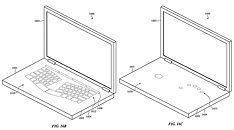Monday, August 6th 2018

Apple Files Patent for a MacBook with Virtual Keyboard and Invisible Trackpad
Did you know, that the home buttons on the iPhone 7/Plus, and iPhone 8/Plus aren't real buttons? It's a flat surface with pressure and fingerprint sensors, and when pushed hard enough, the Taptic module underneath simulates the tactile-feedback of pushing a real SMD button (which is why the button feels jammed when the iPhone is powered down). Apple's latest generation of MacBooks already have real keyboards with extremely short key travel, that's well enough received by its users to convince the company to toy with a notebook with completely virtual keyboards.
Apple filed patent applications for a new generation of MacBooks that completely lack physical keyboards, and instead have two screens on the opposing halves of the traditional notebook clam-shell. The upper half has a higher-resolution main screen, while the lower half has a slightly lower-resolution screen that's good enough to display virtual keyboards of any shape, layout or character-set; in addition to more content. This screen will have toughened glass, and a super-sensitive capacitive 3D touch layer, and Taptic modules underneath. The trackpad, too, is virtual, and can be located wherever you like. Apple will give MacOS more gesture-based control riding on the success of the iPhone X. The patent application shows that Apple has succeeded in simulating keyboards' tactile-feedback on Taptic, and it's only a matter of time before notebooks with real keyboards could be relegated to sub-premium market segments.
Source:
WCCFTech
Apple filed patent applications for a new generation of MacBooks that completely lack physical keyboards, and instead have two screens on the opposing halves of the traditional notebook clam-shell. The upper half has a higher-resolution main screen, while the lower half has a slightly lower-resolution screen that's good enough to display virtual keyboards of any shape, layout or character-set; in addition to more content. This screen will have toughened glass, and a super-sensitive capacitive 3D touch layer, and Taptic modules underneath. The trackpad, too, is virtual, and can be located wherever you like. Apple will give MacOS more gesture-based control riding on the success of the iPhone X. The patent application shows that Apple has succeeded in simulating keyboards' tactile-feedback on Taptic, and it's only a matter of time before notebooks with real keyboards could be relegated to sub-premium market segments.

30 Comments on Apple Files Patent for a MacBook with Virtual Keyboard and Invisible Trackpad
It would be interesting to compare any patents for that against this.
While i think it may not be as confortable as real buttons, it should significantly save them space and money while lowering complexity, however increasing the battery drain and greatly increasing the programming needed to be done.
www.techpowerup.com/forums/threads/lenovo-yoga-book-generation-2-beats-apple-in-the-style-game.244851/
Edit:Oooh, okay, now I get it, just depends on the force used then. Could work, I guess.
Now, before you respond with "but the on-screen keyboard on iPhone 7 sucks," I'll preempt you with "the home button on the iPhone 7 doesn't suck (feels like pushing a real button, because it's backed by that Taptic module). Now imagine a Taptic module under the entire bottom screen, with a non-sucking tactile-feedback under each virtual key à la that iPhone 7 home-button."
Try typing on a flat surface without looking on the keys... It doesn't work, as your fingers have no sense of what they're touching, as you can't feel the individual keys.
That's why all of these "concepts" fail. It's a cool idea to have re-configurable keyboards, but unless the keyboards can predict where you fingers are going to land and which letter it is you want to type...
This looks great in sci-fi movies, but in reality, it doesn't work particularly well. We've had laser keyboards (fail) and as linked above (plus that one Asus was supposed to make a few years ago), using a second screen as a keyboard works poorly as a productivity tool and this is why this concept hasn't taken off, haptic feedback or not.
In my mind, the next big evolution/revolution will be when we're able to interact directly with a computer, as in what you think is what the computer outputs. We're still a good few years away from that, but we're getting closer.
Apple is good at the IP/Patent game, that is almost all they are good at.
Maybe you will be required to slap it around some times after a year of use. I guess you have to be double kinky with this HAHAHA.
They're still coasting off of what Jobs put in. It's just the same stuff thinner and lighter with fewer ports/buttons.
In practice similar software is already in use for overlays, but in an opaque format, with the ability to switch on and off.
Good luck with stealing ideas Apple, it's never stopped you before.
I hate patents that doesn't protect research and dev investment, but rather stop healthy competition. I guess you don't need much R&D to put a second screen.
Pretty sure Acer can start preparations for a lawsuit even before this "wondertech" comes to market.
EDIT: And I almost forgot about slightly more "fresh" ASUS Project Precog
Found it.
Still, it's fun to see Apple try to patent something that other companies have been doing for years. I wouldn't be surprised if they got the patent, given how utterly broken that system is. They probably have some obscure and functionally irrelevant additions and tweaks that somehow makes this a "new idea".